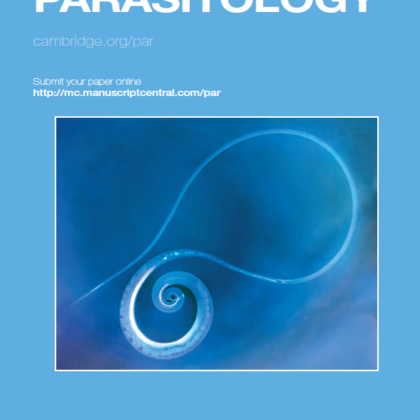Cyclospora cayetanensis comprises at least 3 species that cause human cyclosporiasis
The latest Paper of the Month for Parasitology is “Cyclospora cayetanensis comprises at least 3 species that cause human cyclosporiasis” and is available Open Access.
Despite its impact on United States (US) food safety since the 1990’s, efforts to understand Cyclospora cayetanensis genetics only really began within the last 7 years. However, we have learned a great deal over that time; genotyping technologies now exist for Cyclospora, and these are being used routinely to complement cyclosporiasis outbreak investigations performed by US public health agencies. These outbreak investigations –– complemented by the new genotyping technologies –– help public health agencies to quickly identify fresh produce contaminated with Cyclospora so that public health and regulatory authorities can take action to prevent further illnesses. This ultimately ensures that consumers have access to safe and unadulterated fresh foods.
The role of the US Centers for Disease Control and Prevention (CDC) is to coordinate national efforts to sequence Cyclospora isolates. A library of Cyclospora genotypes is maintained at CDC in addition to epidemiologic data linked to these genotypes. Several US state public health Departments and the Public Health Agency of Canada also participate in the sequencing of Cyclospora genotypes, contributing to the diversity of genotypes in CDCs library. This library was established in 2018, and expands yearly as new Cyclospora infections are identified. These genotypes comprise sets of Cyclospora alleles currently from 8 key genomic regions that are amplified from DNA extracted from a cyclosporiasis patient’s feces and then sequenced using Illumina technology. New genotypes are continually clustered alongside older ones to explore epidemiologic trends over time. This clustering is performed by sophisticated computational methods that compare sets of Cyclospora alleles sequenced from each patient to determine which infections are likely caused by genetically related Cyclospora parasites and which are not. When this work began in 2018 –– during the annual US cyclosporiasis peak period (occurring roughly from May to August) –– two genetically distinct types of Cyclospora emerged; these were observed again in 2019 and in 2020 (and every year since). Even more intriguing, was that the proportion of infections caused by these two types remained strikingly consistent each year; about two thirds of infections were caused by a more common variety while one third were caused by a second, less common type.
This persistent two-type population structure prompted a deep dive into the genetic features driving this population split, and formed the basis of our study. We identified several sections of the genome that distinguished these two Cyclospora types, but perhaps the most interesting observation was that these two types seemingly do not swap genes with one another. Specifically, after examining thousands of genotypes, we saw that for particular genes certain combinations of alleles were common in infections caused by one Cyclospora type or the other, yet other theoretically possible allele combinations were rarely (or never) detected in patients. We concluded that these two Cyclospora types do not reproduce with one another, for if they did, certain allele combinations would occur frequently, but they didn’t. In light of the evidence for reproductive isolation, we proposed a species level distinction; the name Cyclospora ashfordi was assigned to the less common variety of Cyclospora in honor of eminent parasitologist R.W. Ashford, while C. cayetanensis was retained for the more common variety.
Now on to the third Cyclospora species our study describes: To increase the diversity of CDCs genotype library, isolates from various countries were genotyped, including one from China. This Chinese isolate possessed certain unique alleles in its genotype; alleles never observed in the thousands of genotyped US isolates. As part of earlier work performed at CDC, several draft Cyclospora genomes had been sequenced (including for the Chinese isolate), allowing us to compare these genomes closely. These comparisons revealed numerous genetic differences between the Chinese type and all other types examined. We concluded that the Chinese strain was sufficiently distinct to warrant its taxonomic separation from C. cayetanensis. It was assigned the name Cyclospora henanensis, reflecting the origin of the type strain (Henan province, China).
The pros and cons of erecting new species to accommodate these three Cyclospora types were considered deeply prior to publishing this work. Ultimately, we felt it warranted primarily because reproductive isolation is an important prerequisite for distinguishing species as defined by the biological species concept. There are also benefits to assigning organisms to new names, where warranted. For instance, from a practical standpoint a species name provides novel organisms with “character”; it encompasses a set of features, allowing scientists to freely discuss the organism by a name that imparts important information about these features. Without a name, such discussion becomes cumbersome indeed.
Finally, it is worth noting that the three human-infecting Cyclospora species from our study are seemingly identical at their 18S rRNA genes, yet we presented ample data supporting their reproductive isolation. Consequently, this study highlights that widely used 18S rRNA gene barcoding methods for assigning or excluding protozoan parasites to or from one operational taxonomic unit or another, likely underestimate the species diversity of protozoa, which may have implications that extend beyond their taxonomy.

The paper “Cyclospora cayetanensis comprises at least 3 species that cause human cyclosporiasis” by Joel Leonard Nicholas Barratt, John Shen, Katelyn Houghton, Travis Richins, Sarah G. H. Sapp, Vitaliano Cama, Michael J. Arrowood, Anne Straily and Yvonne Qvarnstrom, published in Parasitology, is available Open Access.





